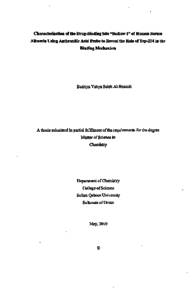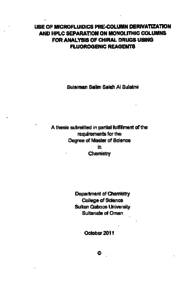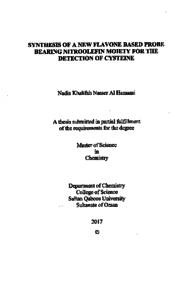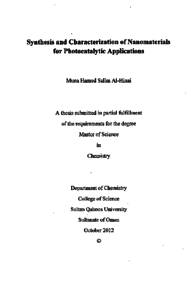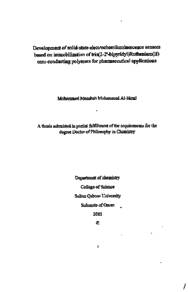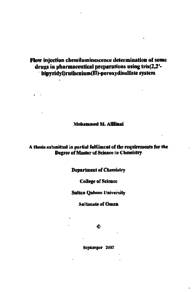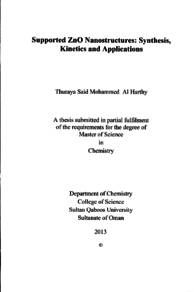Document
Characterization of the drug-binding site "Sudlow I" of human serum albumin using anthranilic acid probe to reveal the role of Trp-214 in the binding mechanism
Publisher
Sultan Qaboos University
Gregorian
2010
Language
English
Subject
English abstract
Anthranilic acid (AA) was used in this project to probe the drug-binding site Sudlow I in subdomain IIA of human serum albumin (HSA) using steady-state and time-resolved spectroscopic measurements. The spectroscopy of AA was first characterized in different solvents of varying polarity and hydrogen bonding capability. Analysis of the absorption and fluorescence spectra reveals that AA exists as an anion in water only. The Stokes shift of AA in different solvents was found to be linearly correlated with the normalized molar transition energy of solvent polarity (EM). The longest lifetime of AA was measured in water and is attributed to solvation of the polar groups of the molecule. Excimer formation containing two AA molecules stabilized by intermolecular hydrogen bonds was observed at a high concentration of AA in water.
Characterization of the drug-binding site of HSA was performed by measuring the change in fluorescence of both AA and of HSA itself upon protein ligand recognition. A large quenching in the fluorescence intensity of HSA and a reduction in its fluorescence lifetime were observed upon the addition of AA. The results indicate that AA interacts with the tryptophan residue (Trp-214) in subdomain IIA of HSA. The reduction in the fluorescence of Trp-214 is due to energy transfer from this residue to AA. The calculated distance between Trp-214 and AA using Förster's theory of energy transfer and the estimated quenching rate constant using a Stern-Volmer plot both point to a major contribution from static quenching to the quenching mechanism in the AA:HSA complex. Binding of AA in HSA was also
udied using a binding isotherm and AA was found to selectively bind in subdomain IIA only up to a concentration of 10 times that of HSA. Selective interaction between AA and Trp-214 results in partial unmasking of fluorescence from tyrosine. The measured steady-state and time-resolved anisotropy of AA in solution and in the HSA protein indicates that the AA molecule is caged inside the binding site of HSA and its free rotation is restricted. A slight decrease in intensity and a blue shift in the AA fluorescence peak were observed in the presence of HSA. The results are explained to be due to a direct interaction between AA and Trp-214 in the excited state.
Chemical unfolding of HSA in guanidine hydrochloride (GdnHCl) was found to start at GdnHCl concentration at 2.0 M and is complete at 6.0 M. Upon unfolding, two fluorescence peaks were observed. One peak was assigned to fluorescence from Trp-214 in a polar environment and the other peak was assigned to fluorescence from tyrosine. In the presence of AA, both fluorescence peaks were slightly quenched which strongly support the assignment of the tyrosine peak to be due mainly to the Tyr-263 residue in subdomain LA. Finally, dilution refolding of denatured HSA was examined. The results indicate that the refolding mechanism is reversible without the need for any refolding agent. The presence of AA during the processes of unfolding and refolding causes only slight quenching in the HSA fluorescence. The results indicate that the small size of the AA molecule is hardly causing any deformation to the protein structure which makes this molecule a suitable probe to study binding sites in proteins and in other supramolecular systems.
Member of
Resource URL
Arabic abstract
لقد استخدم حمض الأنثرائيليك في هذا البحث كمجس لكشف موقع ربط العقاقير(سادلو !) في الحيز الفرعي IIA لألبومين المصل البشري (Human Serum Albumin) باستخدام تحاليل الحالة المستقرة والوقت المحدد الطيفية. وتمت دراسة تحاليل الطيفية لحمض الأنثرانيليك أولا في مذيبات بمختلف القطبية وقابلية الرابطة الهيدروجينية. وتظهر تحاليل الإمتصاص والإشعاع الطيفي أن حمض الأنثرانيليك يكون كجزي ایونی سالب في الماء فقط. ولقد وجد أن هناك علاقة طردية بين إزاحة ستوكس لحمض الأنثرانيليك في المذيبات المختلفة والطاقة الإنتقالية المولارية المتعادلة للمذيبات. ووجد أيضا أن أطول عمر لحمض الأنثرائيليك يوجد في الماء وهذا يعزو إلى ذوبانية الماء في المجموعات القطبية من حمض الأنثرانيليك. وقد ظهر في التراكيز العالية لحمض الأنثرانيليك في الماء إلى تكوين الإكسايمر الذي يحتوي على جزيئين من حمض الأنثرانيليك التي ترتبط برابطة هيدروجينية ولقد تمت دراسة خصائص موقع ارتباط العقاقير في البومين المصل البشري عن طريق تتبع تغير الإشعاع لحمض الأنثرانيليك و ألبومين المصل البشري بعد عملية الإرتباط. ولقد تبين أن هناك انخفاضا في كثافة وعمر إشعاع ألبومين الممل البشري في وجود حمض الأنثرانيليك. وتشير هذه النتائج أن حمض الأنثرانيليك يتفاعل مع الحمض الأميني 214-Trp في الحيز الفرعي IA لألبومين المصل البشري وان الإنخفاض في الإشعاع كان نتيجة لتحول الطاقة من الحمض الأميني 214-Trp إلى حمض الأنثرانيليك. وتشير المسافة المحسوبة بين الحمض الأميني 214-Trp و حمض الأنثرائيليك باستخدام نظرية طاقة تحول رنين فورستر ومعدل انتقال الطاقة المحسوبة عن طريق معادلة ستيرن فولمر أن المساهم الأعلى في آلية انتقال الطاقة في حمض الأنثرانيليك و البومين المصل البشري هي طاقة استاتيكية. ولقد تمت دراسة آلية ارتباط حمض الأنثرائيليك بألبومين المصل البشري أيضا عن طريق دالة الربط ثابتة الحرارة ووجد أن حمض الأنثزانيليك يرتبط بالحيز الفرعي IIAل ألبومين المصل البشري إلى تركيز عشر مرات من حمض الأنثرانيليك بالنسبة لتركيز البومين المصل البشري، وقد أدي التفاعل الإنتقائي بين حمض الأنثرائيليك والحمض الأميني 214-Trp إلى ظهور جزئي لإشعاع tyrosine. وتشير نتائج تباين الخصائص الحمض الأنثرانيليك في المحلول وفي بروتين اليومين المصل البشري في الحالة المستقرة والوقت المحدد أن حمض الأنثرائيليك حبس في موقع الربط بالبومين المصل البشري وكان دورانه الحر مقید؛ وقد وجد أن هناك انخفاض في إشعاع حمض الأنثرانيليك وإزاحة أقصر لطول الموجي في وجود البومين المصل البشري وهذا يدل على أن هناك ارتباط مباشر بين حمض الأنثرانيليك والحالة المثارة من الحمض الأميني 214-Trp ووجد أيضا أن التمديد الكيميائي لألبومين المصل البشري باستخدام جوانیداین حمض الهيدروكلوريك يبدا عند تركيز 2 . 0M من جوانيداين حمض الهيدروكلوريك وينتهي عند تركيز 6 . 0M. وخلال التمديد الكيميائي لألبومين المصل البشري يظهر إشعاعين. أحد الإشعاعين نتيجة 214-Trp في البيئة القطبية والإشعاع الآخر بسبب tyrosine. وفي وجود حمض الأنثرائيليك يظهر انخفاض بسيط في كلا الإشعاعين والذي يؤيد تعين إشعاع tyrosine نتيجة الحمض الأميني 263-Tyr المتمركز في الحيز الفرعي IIA. واخيرا تم إعادة ثني البومين المصل البشري المتمدد بالتخفيف وتظهر النتائج أن آلية الثني عكسية بدون إضافة عوامل تساعد على الثني، وفي وجود حمض الأنثرائيليك خلال عمليات التمديد والثني لألبومين المصل البشري يظهر انخفاض بسيط في اشعاعه والذي يشير إلى أن صغر حجم حمض الأنثرانيليك لم يسبب تغير في تركيب البروتين وهذا يجعل حمض الأنثرانيليك مجس مناسب لدراسة مواقع الارتباط في البروتينات وفي الأنظمة .
Category
Theses and Dissertations

